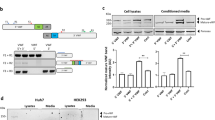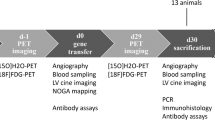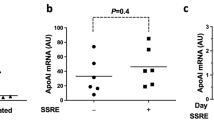Abstract
We have aimed at selective gene delivery to vascular endothelial cells (EC) at sites of inflammation, by targeting E-selectin, a surface adhesion molecule that is only expressed by activated EC. An anti-E-selectin mAb, 1.2B6, was complexed with the adenovirus vector AdZ.FLAG (expressing the FLAG peptide) by conjugating it to an anti-FLAG mAb. Gene transduction of cultured EC was increased 20-fold compared with AdZ.FLAG complexed with a control bsAb providing EC were activated by cytokines. The anti-E-selectin-complexed vector transduced 29 ± 9% of intimal EC in segments of pig aorta cultured with cytokines ex vivo, compared with less than 0.1% transduced with the control construct (P < 0.05). this strategy could be developed to target endothelium in inflammation with genes capable of modifying the inflammatory response.
This is a preview of subscription content, access via your institution
Access options
Subscribe to this journal
Receive 12 print issues and online access
$259.00 per year
only $21.58 per issue
Buy this article
- Purchase on Springer Link
- Instant access to full article PDF
Prices may be subject to local taxes which are calculated during checkout





Similar content being viewed by others

References
Wickham TJ, Mathias P, Cheresh DA, Nemerow GR . Integrins αvβ3 and αvβ5 promote adenovirus internalization but not virus attachment Cell 1993 73: 309–319
Wickham TJ, Filardo EJ, Cheresh DA, Nemerow GR . Integrin αvβ5 selectively promotes adenovirus mediated cell membrane permeabilization J Cell Biol 1994 127: 257–264
Mathias P, Wickham T, Moore M, Nemerow G . Multiple adenovirus serotypes use αv integrins for infection JVirol 1994 68: 6811–6814
Hong SS et al. Adenovirus type 5 fiber knob binds to MHC class I α2 domain at the surface of human epithelial and B lymphoblastoid cells EMBO J 1997 16: 2294–2306
Bergelson JM et al. Isolation of a common receptor for Coxsackie B viruses and adenoviruses 2 and 5 Science 1997 275: 1320–1323
Wickham TJ et al. Increased in vitro and in vivo gene transfer by adenovirus vectors containing chimeric fiber proteins J Virol 1997 71: 8221–8229
Chen S-J, Wilson JM, Muller DWM . Adenovirus-mediated gene transfer of soluble vascular cell adhesion molecule to porcine interposition vein grafts Circulation 1994 89: 1922–1928
Merrick AF et al. Comparison of adenovirus gene transfer to vascular endothelial cells in cell culture, organ culture and in vivo Transplantation 1996 62: 1085–1089
Nabel EG, Plautz G, Nabel GJ . Site-specific gene expression in vivo by direct gene transfer into the arterial wall Science 1990 249: 1285–1288
Lemarchand P, Jones M, Yamada I, Crystal RG . In vivo gene transfer and expression in normal uninjured blood vessels using replication-deficient recombinant adenovirus vectors Circ Res 1993 72: 1132–1138
Guzman RJ et al. Efficient and selective adenoviral-mediated gene-transfer into vascular neointima Circulation 1993 88: 2838–2848
Steg PG et al. Arterial gene transfer to rabbit endothelial and smooth muscle cells using percutaneous delivery of an adenoviral vector Circulation 1994 90: 1648–1656
Schulick AH et al. Endothelium-specific in vivo gene transfer Circ Res 1995 77: 475–485
Wickham TJ et al. Targeted adenovirus gene transfer to endothelial and smooth muscle cells by using bispecific antibodies J Virol 1996 70: 6831–6838
Tedder TF, Steeber DA, Chen A, Engel P . The selectins: vascular adhesion molecules FASEB J 1995 9: 866–873
Cotran RS et al. Induction and detection of a human endothelial activation antigen in vivo J Exp Med 1986 164: 661–666
Pober JS, Cotran RS . Cytokines and endothelial cell biology Physiol Rev 1990 70: 427–451
von Asmuth EJU et al. Evidence for endocytosis of E-selectin in human endothelial cells Eur J Immunol 1992 22: 2519–2526
Smeets EF et al. Phosphorylation of surface E-selectin and the effect of soluble ligand (sialyl Lewisx) on the half-life of E-selectin Eur J Immunol 1993 23: 147–151
Subramaniam M, Koedam JA, Wagner DD . Divergent fates of P-selectins and E-selectins after their expression on the plasma membrane Mol Biol Cell 1993 4: 791–801
Kuijpers TW et al. Cytokine-activated endothelial cells internalize E-selectin into a lysosomal compartment of vesiculotubular shape: a tubulin-driven process J Immunol 1994 152: 5060–5069
Spragg DD et al. Immunotargeting of liposomes to activated vascular endothelial cells: a strategy for site-selective delivery in the cardiovascular system Proc Natl Acad Sci USA 1997 94: 8795–8800
Varga MJ, Weibull C, Everitt E . Infectious entry pathway of adenovirus type 2 J Virol 1991 65: 6061–6070
Greber UF, Willetts M, Webster P, Helenius A . Stepwise dismantling of adenovirus 2 during entry into cells Cell 1993 75: 477–486
Wickham TJ, Haskard D, Segal D, Kovesdi I . Targeting endothelium for gene therapy via receptors upregulated during angiogenesis and inflammation Cancer Immunol Immunother 1997 45: 149–151
Keelan ETM et al. Characterization of E-selectin expression in vivo using a radiolabelled monoclonal antibody Am J Physiol 1994; 266: H279–H290
Binns RM et al. In vivo E-selectin upregulation correlates with early infiltration of PMN, later with PBL-entry: mAbs block both Am J Physiol 1996; 270: H183–H193
Chapman PT et al. Characterization of E-selectin expression, leukocyte traffic and clinical sequelae in urate crystal-induced inflammation: an insight into gout Br J Rheumatol 1996 35: 323–334
Binns RM et al. The role of E-selectin in lymphocyte and polymorphonuclear cell recruitment into cutaneous delayed hypersensitivity reactions in sensitised pigs J Immunol 1996 157: 4094–4099
Chapman PT et al. Use of a radiolabeled monoclonal antibody against E-selectin for imaging endothelial activation in rheumatoid arthritis Arthr Rheum 1996 39: 1371–1375
Bhatti M et al. Visualizing E-selectin in the detection and evaluation of inflammatory bowel disease Gut 1998 43: 40–47
Merrick AF et al. Comparison of adenovirus gene transfer to vascular endothelial cells in cell culture, organ culture and in vivo Transplantation 1996 62: 1085–1089
Mahiouz DL, Aichinger G, Haskard DO, George AJT . Expression of recombinant anti-E-selectin single-chain Fv antibody fragments in stably transfected insect cell lines J Immunol Meth 1998 212: 149–160
Martens CL et al. Peptides which bind E-selectin and block neutrophil adhesion J Biol Chem 1995 270: 21129–21136
Krasnykh V et al. Characterization of an adenovirus vector containing a heterologous peptide epitope in the H1 loop of the fiber knob J Virol 1998 72: 1844–1852
Zinn KR et al. Imaging and tissue biodistribution of Tc-99m-labeled adenovirus knob (serotype 5) Gene Therapy 1998 5: 798–808
Yang Y et al. Cellular immunity to viral antigens limits E1-deleted adenoviruses for gene therapy Proc Natl Acad Sci USA 1994 91: 4407–4411
Tripathy SK, Black HB, Goldwasser E, Leiden JM . Immune responses to transgene-encoded proteins limit the stability of gene expression after injection of replication-defective adenovirus vectors Nature Med 1996 2: 545–550
Engelhardt JF, Ye X, Doranz B, Wilson JM . Ablation of E2A in recombinant adenoviruses improves transgene persistence and decreases inflammatory response in mouse liver Proc Natl Acad Sci USA 1994 91: 6196–6200
Kay MA et al. Long-term hepatic adenovirus-mediated gene expression in mice following CTLA4Ig administration Nat Genet 1995 11: 191–197
Mack CA et al. Circumvention of anti-adenovirus neutralizing immunity by administration of an adenoviral vector of an alternate serotype Hum Gene Ther 1997 8: 99–109
Corkill MM et al. Gold treatment of rheumatoid arthritis decreases synovial expression of the endothelial leukocyte adhesion receptor ELAM-1 J Rheumatol 1991 18: 1453–1460
Koch AE et al. Immunolocalization of endothelial and leukocyte adhesion molecules in human rheumatoid and osteoarthritic synovial tissues Lab Invest 1991 64: 313–320
Ohtani H et al. Light and electron microscopic immunolocalization of endothelial leucocyte adhesion molecule-1 in inflammatory bowel disease. Morphological evidence of active synthesis and secretion into vascular lumen Virchows Arch A Pathol Anat Hispathol 1992 420: 403–409
Koizumi M et al. Expression of vascular adhesion molecules in inflammatory bowel disease Gastroenterology 1992 103: 840–847
Groves RW et al. Endothelial leukocyte adhesion molecule-1 (ELAM-1) expression in cutaneous inflammation Br J Dermatol 1991 124: 117–123
van der Wal AC, Das PK, Tigges AJ, Becker AE . Adhesion molecules on the endothelium and mononuclear cells in human atherosclerotic lesions Am J Pathol 1992 141: 1427–1433
Wood KM, Cadogan MD, Ranshaw AL, Parums DV . The distribution of adhesion molecules in human atherosclerosis Histopathology 1993 22: 437–444
Slater DN, Sloan JM . The porcine endothelial cell in tissue culture Atherosclerosis 1975 21: 259–272
Wellicome SM et al. A monoclonal antibody that detects a novel antigen on endothelial cells that is induced by tumor necrosis factor, IL-1 or lipopolysaccharide J Immunol 1990 144: 2558–2565
Tsang Y et al. Porcine E-selectin: cloning and functional characterization Immunology 1995 85: 140–145
Author information
Authors and Affiliations
Rights and permissions
About this article
Cite this article
Harari, O., Wickham, T., Stocker, C. et al. Targeting an adenoviral gene vector to cytokine-activated vascular endothelium via E-selectin. Gene Ther 6, 801–807 (1999). https://doi.org/10.1038/sj.gt.3300898
Received:
Accepted:
Published:
Issue Date:
DOI: https://doi.org/10.1038/sj.gt.3300898
Keywords
This article is cited by
-
Targeting therapeutics to endothelium: are we there yet?
Drug Delivery and Translational Research (2018)
-
Targeted delivery of therapeutics to endothelium
Cell and Tissue Research (2009)
-
Ligand-directed targeting of genes to the site of disease
Nature Medicine (2003)
-
Targeting gene therapy vectors to the vascular endothelium
Current Atherosclerosis Reports (2003)
-
Cell physiology as a variable in gene transfer to endothelium
Current Atherosclerosis Reports (2003)


